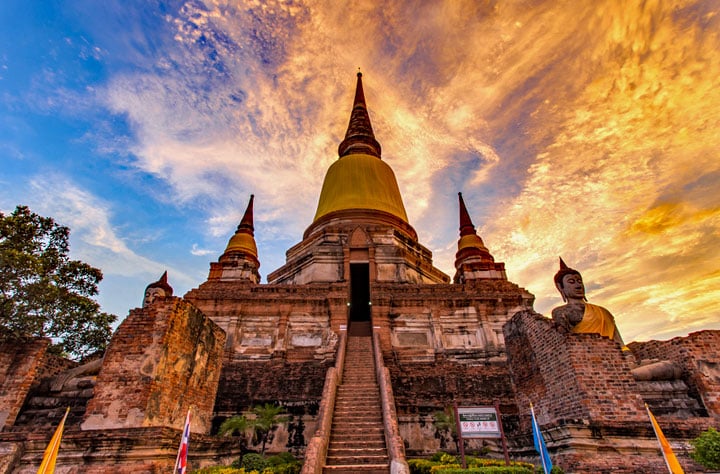Wat Yai Chaimongkol in Ayutthaya (video)
Ayutthaya is the ancient capital of Siam. It is located 80 km north of the current capital of Thailand.
The historic city of Ayutthaya has a special and rich history. In 1767 the city was abandoned after destruction by the Burmese. This historic riverside city is home to the spectacular and impressive remains of ancient temples.
Wat Yai Chaimongkol, also known as Wat Yai Chai Mongkhon, is a Buddhist temple of great historical importance located in Ayutthaya, Thailand. The temple is famous for its large, imposing chedi (stupa), which is visible from afar and forms a distinctive image of the ancient city of Ayutthaya, which was once the capital of the Kingdom of Ayutthaya.
History
The temple was originally founded in the fourteenth century, under the name Wat Pa Kaeo. Later, after the victory over the Burmese forces in 1592, King Naresuan renamed the temple “Wat Yai Chai Mongkhon” as a sign of his victory and to emphasize his power.
The temple played an important role in Thailand's history as a center of learning and spiritual practice. It was also associated with the promotion of Theravada Buddhism in the region. Furthermore, it was known for the role it played in the training of monks, with many receiving their religious instruction here.
Architecture
Wat Yai Chaimongkol is known for its architecture, which reflects the power and aesthetics of the Ayutthaya era. The most striking feature of the temple is the large chedi, built in a typical Ayutthaya style, which rises high above the ruins of the temple. The chedi is surrounded by smaller chedis, which served as funerary monuments for important monks and nobles.
The temple also contains a large reclining Buddha and a viharn (prayer hall), offering visitors a glimpse of the art and craftsmanship of the period. The walls and columns of the viharn are often richly decorated with murals and inscriptions, depicting stories from Buddhist teachings.
Meaning
Wat Yai Chaimongkol is not only a major tourist attraction, but it also remains an active religious site, where local residents and monks still perform daily rituals and ceremonies. It is a place of reflection and respect for the Buddhist faith, as well as a reminder of Thailand's rich cultural and historical heritage.
Conservation
Over the years, the temple has undergone several restoration projects to preserve the structures and protect them from decay. The ruins of Ayutthaya, including Wat Yai Chaimongkol, have been recognized as a UNESCO World Heritage Site, underlining its significance as an important cultural and historical monument.
The visit to Wat Yai Chaimongkol offers visitors the opportunity to learn about Thai history, art and religion, and to experience the beauty and serenity of a place that has been a center of spiritual importance for centuries.
What can you see in Ayutthaya?
There are plenty of landmarks and ancient temples scattered around Ayutthaya. You can visit these as part of an organized travel. What is certainly possible is to explore the city by bicycle. There are also tuk-tuks that can take you to the sights you would like to visit.
Ayutthaya Historical Park is located opposite the Chao Sam Phraya National Museum. This historic park is on the UNESCO World Heritage List and has many temples. The temples of Wat Phra Si Sanphet, Wat Mongkhon Bophit, Wat Na Phra Meru, Wat Thammikarat, Wat Ratburana and Wat Phra Mahathat are close to each other and can easily be visited on foot. The visit to the remaining part of the historic park is best done by bicycle.
In this video you can see images of Ayutthaya and the Wat Yai Chaimongkol:


